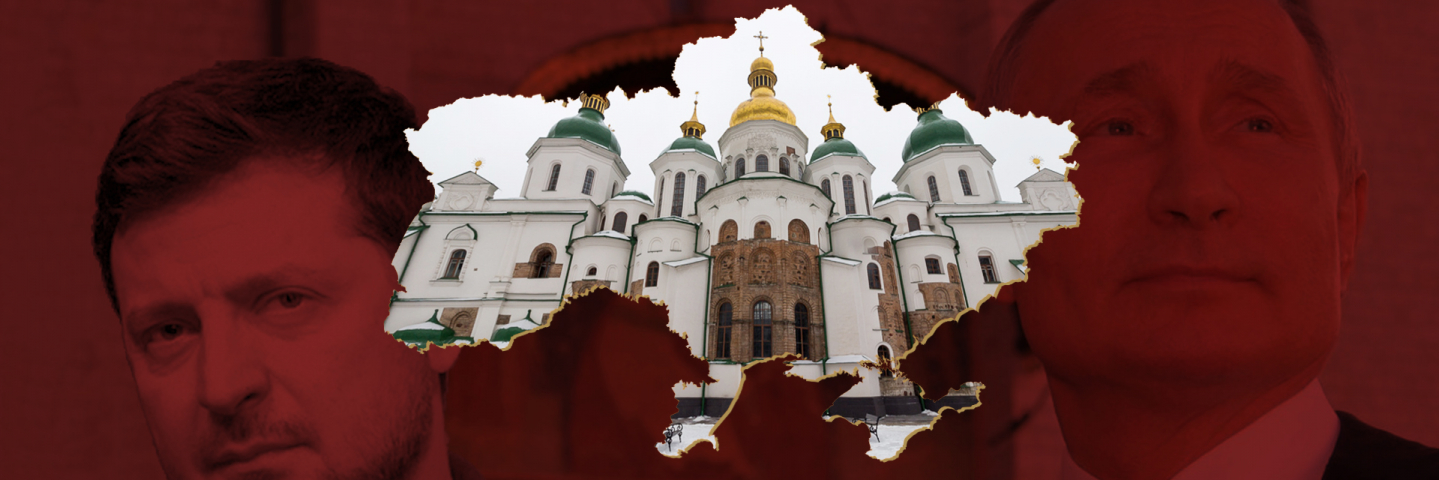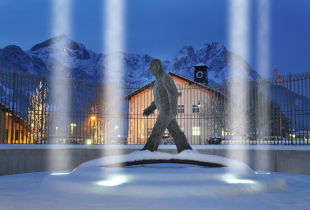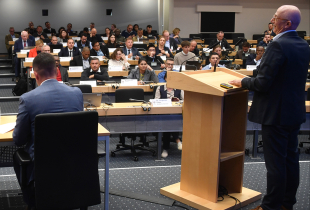
NATO’s Vilnius Summit, Ukraine and Security Guarantees
Introduction
Dmytro Kuleba, Ukraine’s Foreign Minister, penned an article in Foreign Affairs in April 2023 entitled: “Why NATO Must Admit Ukraine.” He argued that the Vilnius NATO Summit should offer a “clear written statement” and “timetable” “laying out a path to accession” which could lead to decision at the Alliance’s 75th anniversary summit in Washington, D.C. in 2024. In June 2023, Andriy Zagorodnyuk, a former Ukrainian Defense Minister, also published a piece - “To Protect Europe, Let Ukraine Join NATO” – which highlighted the security benefits of Ukraine in NATO. It noted that given its land warfare capabilities and real-time experience, Ukraine is best placed to stabilize NATO’s eastern flanks: “If Moscow tried to seize control of territory in Estonia, Latvia, or Lithuania, American troops might not arrive until it is too late. Ukrainian units, by contrast, are nearby. They could make it to the battlefield fast and then do what they’ve done with great success for the last 15 months—stave off Russia.”
The final 11-12 July NATO summit communiqué reaffirmed the 2008 Bucharest decision to admit Ukraine as a member “when Allies agree and conditions are met.” The “conditions” themselves were not fully elaborated, leaving open the possibility that Allies could disagree over whether all “conditions” had been met, just as Hungary and Türkiye had over Sweden’s fast track membership, so prolonging Ukraine’s non-NATO status, and bringing into question accession itself. President Zelenskyy expressed anger at the ambiguity: “It’s unprecedented and absurd when a time frame is set neither for the invitation nor for Ukraine’s membership. While at the same time, vague wording about 'conditions' is added even for inviting Ukraine.”
This was an immediate response, expressing understandable frustration. A week later, how might we assess the significance of the Summit in the round and, in particular, its implications for alternative future Ukrainian trajectories, including security guarantees?
NATO Vilnius Summit
The Summit communiqué noted a normalization of NATO defense and deterrence efforts, including discussing its high readiness forces, and addressing budgetary and preparedness challenges. As NATO Secretary Gen. Stoltenberg noted, the unblocking of Swedish NATO accession (to be the 32nd member), became a “game-changer for European security and will provide an uninterrupted shield from the Baltic to the Black Sea.” The U.S. now intends to move forward with the long-promised $20 billion sale of F-16 jet fighters to Türkiye. President Recep Tayyip Erdoğan has likely concluded that the benefits of leaning into NATO and the West now outweigh costs of veto (although this ought not to be taken to mean he will not return to his familiar role of spoiler in the future, should it appear to be in his interests).
The communiqué also addressed China, but not as an adversary: “We must continue to engage with Beijing to tackle today’s global challenges, including nuclear proliferation and climate change. At the same time, China should use its considerable influence over Russia to end its illegal war in Ukraine. So far, however, Beijing has not condemned Moscow’s aggression and is instead increasing its economic, diplomatic, and military cooperation with Russia.” NATO’s Indo-Pacific partners–Australia, New Zealand, the Republic of Korea, and Japan-were also Summit participants: “The Indo-Pacific is important for NATO, given that developments in that region can directly affect Euro-Atlantic security.”
NATO-Ukraine relations were addressed not just through a commitment to NATO’s “open door” policy but also by the removal of the alliance’s formal membership action plan (MAP) requirement, representing fast-track accession once “conditions” related to good governance and anti-corruption policies have been met. The NATO-Russia Commission was upgraded to a new NATO-Ukraine Council, constituted as a consultation mechanism and forum where both NATO and Ukraine “meet as equals” to discuss strategic objectives. It does not appear to be a body that will assess the conditions that Ukraine would have to fulfil to become a member.
Ukraine also began a negotiation process to formalize and secure “bilateral long-term security commitments and arrangements” with G7 members as it “defends its sovereignty and territorial integrity, rebuilds its economy, protects its citizens, and pursues integration into the Euro-Atlantic community.” In this respect, strategic policy goals have been identified. Ukraine needs to determine the capabilities mix, industrial base, training, intelligence sharing and cyber and other initiatives that would allow it to deter future Russian aggression. Additionally, Ukraine’s economic stability should be resilient, creating conditions that promote its economic and energy prosperity and security. Ukraine should also be provided technical and financial support to meet its immediate needs and drive effective reform and good governance-building that facilitates its Euro-Atlantic integration.
Assessment
In offering an assessment, we can point to four core takeaways. First, although Ukrainian expectations of a timetabled fast-track NATO membership may have constituted its “Holy Grail,” politics is the art of the possible and in reality this fell outside the bounds of what was achievable: there is no current consensus among the 31 allies for admitting Ukraine into NATO. Given this caveat, the Summit results exceeded expectations. Turkish consent on Swedish NATO membership was an unexpected NATO “win” and must have come as a shock for Russia. President Zelenskyy’s expressed frustration can also be understood as performative, as he is able to “mobilize victimhood” to best effect. His disappointment was undoubtedly also a genuine emotion but it may also be a strategy according to the principle of ‘asking more than you hope to get in order to get what you want:' Zelenskyy forces the West to use its “no’s” so that he can optimize outcomes on other fronts, not least securing G-7 security “commitments and arrangements.”
Second, perception within NATO over the probable course of the war shifted from a belief that the war would be prolonged to a realization that the war could be shortened: “support Ukraine for as long as it takes” mutated into the need to “support Ukraine with whatever it takes.” This perception shift in NATO is driven by visible fragmentation of Russia’s strategic and operational level chain-of-command and control, exacerbated by the Wagner rebellion on June 24 and subsequent arrests and dismissals of flag officers in Russia, Kremlin uncertainty and erratic and unpredictable behavior. The fragility of Putin’s regime is much more visible as the cumulative effects of 15 months of war make their presence felt. The ongoing dismantling of the Wagner enterprise (military, media, business components), its obvious utility in Africa for Russian foreign policy, the demands it still makes on the Russian MoD to facilitate its lift and the bizarre meeting with Putin, Prigozhin and 35 Wagner commanders on June 29, all attest to a sense of drift and growing chaos.
In addition, in Russia itself we see a clash of perception between its “fighting generals,” who recognize reserve shortfalls, lack of rotation, deficits in supplies, and the results of artillery duels on the one hand and their frustration with Russian civilian elites and society “business as usual approach” on the others hand. The latter expects “breakthrough,” the former fears “breakdown.” The assumptions underpinning the notion of an armistice (cease-fire) agreement look less stable: it overestimates Russia’s fighting ability and political durability and underestimates Ukraine’s will and determination to win. Putin is deterred from further mobilization by fear that the gubernatorial elections in September 2023 trigger a color revolution: Putin’s deep-seated predictive paranoia and phobias around future instability undercut his ability to stabilize the present.
Third, NATO commits to mid-term and long-term strategic planning based on 2% GDP growth but as set against a Russian military in decline in terms of scale and scope of threat potential in Arctic, Nordic and Baltic regions. Russia’s unprovoked invasion of Ukraine and its conduct during its war of choice has managed to strategically and permanently destroy its image in the west, as well as the reputation and combat effectiveness of its conventional military capability declines, as does Russia’s residual threat to NATO itself. As a result, NATO member states can deliver more and newer military aid to Ukraine, allowing Ukraine to pursue battlefield victory.
Nonetheless, perception shifts aside, the current reality is that the war will be protracted and that even eventual NATO membership does not guarantee Ukraine’s total security, as Russia has carried out hybrid attacks on existing NATO member states. Ukraine then needs to make itself resilient against such attacks but if taken too far a “porcupine strategy” risks facilitating the emergence of a “garrison state” in which martial law, emergency legislation and increased censorship all undermine Ukraine’s EU aspirations. In addition, the provision to Ukraine of long-range weapons are key to its future deterrence ability but risk calculus between Ukraine and Western donors may differ when it comes to deterrence by punishment using such weapons.
Fourth, in terms of risks associated with Ukraine’s NATO membership, the calculus attempts to address two competing sets of assumptions and implications which are constantly challenged in real time. On the one hand, the decision not to offer near-automatic NATO membership for Ukraine is animated by a fear that it could give Russia an incentive to both escalate and prolong its war against Ukraine or widen hostilities by initiating a NATO-Russia war, with the threat of nuclear escalation. Dmitry Medvedev, the deputy chair of Russia's Security Council, after all, states that even increased military assistance to Ukraine by the NATO alliance brings World War Three closer, never mind membership. The assumption here is that as long as Russia is at war with Ukraine, offering Ukraine NATO membership means that NATO automatically enters a state of war with Russia.
However, and on the other hand, such fears are misguided. Article 5 stipulates that each NATO member must take “action as it deems necessary” to help an attacked party. As Andriy Zagorodynyuk notes: “By this standard, Ukraine may as well already be a NATO state. It receives tens of billions of dollars in help from partner nations in the form of sophisticated armaments. It has been the beneficiary of extensive Western military training. It receives detailed U.S. intelligence. And it has never asked for NATO to deploy troops on the ground.” More importantly, U.S. Amb. Kurt Volker argues that a failure to map a clearer pathway to membership as part of a deterrence strategy means that the Russian Federation has no incentive for war to end and every incentive to protract and prolong it. But unless we envisage NATO membership to be offered while the fighting is going on - which even Kyiv did not expect - then this applies anyway. A more pertinent argument: given current fragility in Russia, with the Wagner rebellion a symptom of wider dysfunction, might greater risks lie with non-membership and greater stability with NATO membership? Lastly, as Ukraine was attacked by Russia when it was non-aligned, and non-aligned Finland has not subsequently been attacked when it joined NATO, the case that NATO membership deters Russian military invasion and non-alignment invites them can be made.
To achieve as rapid an integration as possible, given the dangers of prolongation, we might assume that “all-in” NATO support for Ukraine should replace “calibrated escalation.” However, it is difficult to predict that “all-in” support could lead to transformative change on the battlefield. Cluster munitions, for example, compensate for current shortages of ammunition experienced by Ukraine. This potentially relieves time pressure and reduces the possibility of Ukraine having to accept greater risk, but are not transformative. But an “all-in” approach would not be risk free: depleted western arsenals may undercut contingencies against China, and if “all-in” Plan B replaces “calibrated escalation” Plan A, what then will be Plan C?
In the week following the NATO Summit, Russia did not extend a grain agreement concluded on July 22, 2022, in Istanbul for 120 days and extended several times thereafter. President Zelenskyy noted that two agreements were in existence. The first between Ukraine, Türkiye, and the UN, and the second between Russia, Türkiye, and the UN. He suggested that Ukraine, the UN and Türkiye continue the grain initiative using the Black Sea corridor, with Türkiye taking responsibility with Ukraine and potentially other littoral states, such as Bulgaria and Romania, to ensure safe passage of Ukrainian grain. This would create de facto security guarantees for Ukraine, albeit ones that are sectoral and sub-regional specific (NW Black Sea). President Erdoğan and Putin have a competitive relationship and Erdoğan has invited Putin to visit. In return, Putin needs a face-saving gesture. If no meeting occurs then Türkiye, having returned Azov brigade soldiers and commanders to Ukraine and called for Ukraine’s NATO membership, may well press forward with decisions over safe-passage, though actual guarantees are high risk and remain a reserve option for Erdoğan “the peace-bringer.”
Conclusion
The NATO Vilnius Summit occurred at a moment in which perceptions were shifting on a number of fronts. First, NATO’s role consolidated around one primarily centered on collective defense. This was reflected in NATO’s force generation model that plans to have 100,000 forces deployable across the eastern flank in the first 10 days (200,000 in 10-30 days and 500,000 within 30-80 days) and the 2% GDP expenditure on defense becoming the floor not ceiling. Second, with the removal of political blocks to Swedish accession, the alliance appears more unified and larger than ever, with greater consensus around what was acceptable, affordable and strategically appropriate. Third, the understanding of Ukraine’s trajectory and necessary support, and Russia’s actual power, dysfunction and future, are shifting.
The Summit did not offer fast-track membership but it did advance the conditions that allow for that membership – military and economic support for Ukraine that increase its chances to restore statehood. Russia seeks to downplay the Summit’s importance, arguing Kyiv’s failure to achieve membership signifies abandonment and highlights Russia’s ability to deter. Yet, if Ukraine restores its 1991 statehood, then it is highly improbable that Russia’s refusal to concede war termination will be allowed to veto Ukraine’s NATO membership. A weakened and damaged President Putin will need to run for his “first term” presidency if he is to stay in control of Russia. The politics of this dynamic will likely further impede Russia’s ability to prosecute its war of imperial aggression. NATO’s next Summit is in Washington DC, July 2024, before the U.S. elections. We can expect a transformed strategic environment by then.
About the Authors
Dr. Pavel K. Baev is Research Professor at the Peace Research Institute Oslo (PRIO). He is also a Senior Non-Resident Scholar at the Brookings Institution (Washington, D.C.) and a Senior Research Associate with the French International Affairs Institute (IFRI, Paris). Dr. Baev specializes in Russian military reform, Russian conflict management in the Caucasus and Central Asia, energy interests in Russia’s foreign policy, and Russian relations with Europe and NATO.
Dr. Mark Galeotti is director of the London-based consultancy Mayak Intelligence, an honorary professor at the University College London School of Slavonic and East European Studies, a senior associate fellow at the Royal United Services Institute, and a senior non-resident fellow at the Institute of International Relations Prague. He is an expert and prolific author on transnational crime and Russian security affairs. His latest books include: Putin’s Wars, from Chechnya to Ukraine (London: Osprey, 2022); The Weaponisation of Everything: A Field Guide to the New Way of War, (New Haven and London: Yale University Press, 2022).
Dr. Graeme P. Herd is a Professor of Transnational Security Studies in the Research and Policy Analysis Department at the George C. Marshall European Center for Security Studies. His latest books include Understanding Russia’s Strategic Behavior: Imperial Strategic Culture and Putin’s Operational Code (London and New York, Routledge, 2022) and Russia’s Global Reach: A Security and Statecraft Assessment, ed. Graeme P. Herd (Garmisch-Partenkirchen: George C. Marshall European Center for Security Studies, 2021).
The George C. Marshall European Center for Security Studies
The George C. Marshall European Center for Security Studies in Garmisch-Partenkirchen, Germany is a German-American partnership and trusted global network promoting common values and advancing collaborative geostrategic solutions. The Marshall Center’s mission to educate, engage, and empower security partners to collectively affect regional, transnational, and global challenges is achieved through programs designed to promote peaceful, whole of government approaches to address today’s most pressing security challenges. Since its creation in 1992, the Marshall Center’s alumni network has grown to include over 15,000 professionals from 157 countries. More information on the Marshall Center can be found online at www.marshallcenter.org.
The Clock Tower Security Series provides short summaries of Seminar Series hosted by the George C. Marshall European Center for Security Studies. These summaries capture key analytical points from the events and serve as a useful tool for policy makers, practitioners, and academics.
The articles in the The Clock Tower Security Series reflect the views of the authors (Pavel Baev, Mark Galeotti, and Graeme P. Herd) and are not necessarily the official policy of the United States, Germany, or any other governments.

